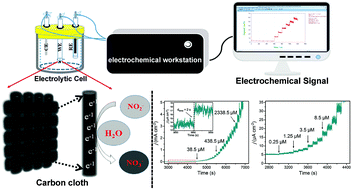High-performance electrochemical nitrite sensing enabled using commercial carbon fiber cloth†
Abstract
Carbon fiber cloth (CC), by virtue of its flexible, conductive, and low-cost features, has generated great interest as the underlying backbone in many electrochemical reactions. Here, we report on our recent finding that CC could be directly employed as an anode for nitrite detection. It exhibited surprisingly high sensing performance toward nitrite with low determination and detection limit, high sensitivity, wide linear detection range, and excellent selectivity and stability, as well as good feasibility of testing nitrite in actual samples. Note that these parameters of CC are comparable or even superior to those of most of the reported carbon-, transition metal-, and noble metal-based advanced nitrite sensors. We also proved that the acid-oxidized CC with rougher surface and more carbon–oxygen functional groups exhibited higher current response and sensitivity toward nitrite. The advantages including superior sensing performance, low electrode cost, no requirement for additional synthetic or complex pretreatment processes, and commercial off-the-shelf nature enable CC to be an ideal electrochemical sensor for nitrite determination.



 Please wait while we load your content...
Please wait while we load your content...